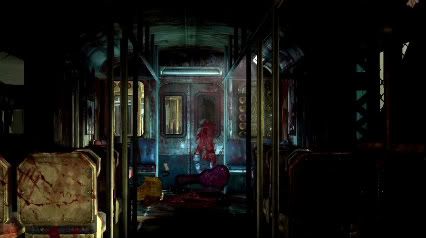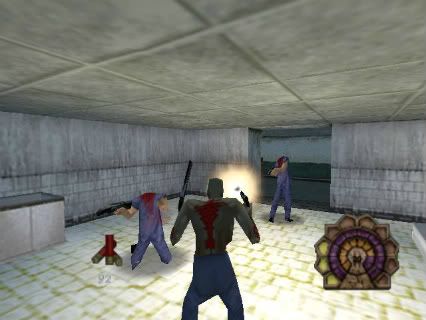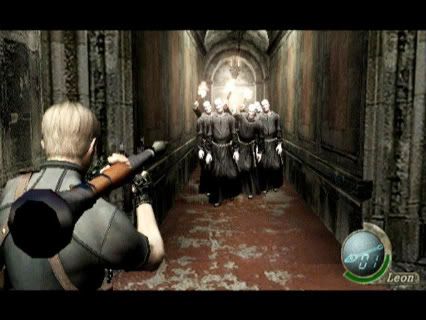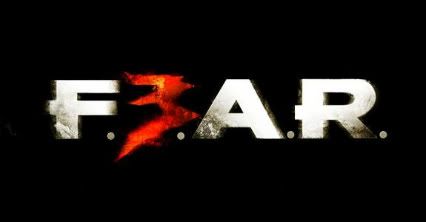This was originally going to be a review of the atrociously acronymed F.3.A.R. (that doesn’t even make any sense! What the hell is the ’3′ supposed to stand for?). Two things resulted in it morphing into an article about horror games in general. Firstly, as the review would have ended up being about seven months late, publishing it would seem a bit… silly. In case you were wondering though, I’d give it 8/10. Secondly however, one thing I was planning to mention only in passing – but which is actually an issue worth looking into – is that it’s a horror game that isn’t actually very scary.
As an FPS, F.E.A.R. 3 is a resounding success. The graphics are pretty good, with a silky smooth frame rate from start to finish. The weapons roster, while fairly limited, is admirably varied in terms of power and fire rate. The franchise’s AI is still far beyond what the competition is capable of, with intelligent use of cover and a worryingly competent understanding of flanking. You may cringe when you learn that the developers have dropped in the odd explosive barrel here and there, though.
As a horror game – which is first and foremost what all three games have been advertised as – it is a failure. A few of the scripted shocks are effective and, yes, there are one or two areas which are distinctly creepy; most notably perhaps the houses decorated with candles, blood and gore, with the rapid footsteps of unseen horrors heard every now and again. For the most part however, there is – ironically – a total lack of fear.
This is largely down to the fact that there are several lengthy, fairly traditional sequences that see you fighting your way past hordes of soldiers to progress. It’s very well done and great fun to play, but these moments also make it extremely easy to forget completely that you’re supposedly playing a horror game. The biggest mistakes are usually made when the game is going full throttle down scary avenue, however. For one thing, it relies too heavily on clichés. The whole ‘young child as monster’ thing has been done to death in the movies now and yes, Alma is central to the story; but why not take the approach the (not much scarier) second game took, and concentrate more on her adult form? Also, please note: if you’re pleased with a visual shock you’ve thought of, repeating it within minutes does not make it scarier. Quite the opposite, in fact.

Unsurprisingly, this game (and many others purporting to be horrors) makes one of the most common mistakes Hollywood never learns from. If you throw a load of monsters on-screen, that’s not horror; that’s a load of monsters. Monster movies and (effective) horror movies are two very, very different things. Therefore, when F.E.A.R. 3 starts throwing fast, leaping, pointy-toothed creatures at the player later in the game yes, it’s a good excuse to whip out the shotgun; but it rapidly drains all horror from the experience. True fear stems from the unknown and, when something is right in front of you trying to rip your face off, you know everything you need to. There’s no sense of fear interfering with your aim.
In the Christmas podcast I briefly reminisced about the original Condemned, and how it was a horror game that worked (if you have a 360 and haven’t played that game, please do so). Speaking for myself I was constantly on edge playing that game, never knowing where the next threat would come from. If I had an extremely rare firearm to hand, I knew that what few bullets I had in the chamber would have to be used wisely. There were to be no ammo pickups. This meant that combat was almost exclusively melee, forcing you to go toe-to-toe with often horrific looking enemies who fought intelligently. Enemies hide regularly and can spring from virtually anywhere; more than once, I jumped as I came under attack while searching for clues in a darkened, seemingly empty room.
If you’re a fan of the Silent Hill games then think, what makes you more tense; fighting one of the twisted, staggering enemies, or wandering through the fog in an unknown area while your radio crackles a warning that… something is nearby?
I remember that I loved, and was scared silly by, the original Shadow Man game upon release. That was almost twelve years ago, so my memories of it are vague at best; but what I do remember are wonderfully crafted moments of horror. Yes, there was a cheap (but damn effective) moment where an enemy jumped out at me from a cupboard in an old, apparently deserted building. One enemy type in particular never failed to creep me out, squawking ‘Shadow Man‘ in a broken voice as, no more than an upper torso, it rapidly dragged itself toward me with its arms. What really sticks out in my mind is the ‘Nursery’ level, populated by hideous creatures, where blood is plastered over everything. Though there are never any children to be seen, the soundtrack of discordant lullabies and cries of unseen babies made for a chilling, uncomfortable experience.

I couldn't find a picture of The Nursery, but these decapitated inmates creeped me out too.
Of course, getting the balance between enjoyable videogame and effective horror experience is not an easy task. It doesn’t help that you can’t please all of the people all of the time. For example, I just can’t seem to enjoy the first few Resident Evil games. I’ve tried playing the original on the Saturn, the PSOne, the DS, and the GameCube; I just can’t get into it. I find the control system obnoxiously awkward, and the save system obscenely, unnecessarily frustrating. For similar reasons, the two or three times I’ve tried playing the sequel soon resulted in a sulk. Oddly however, I managed to finish and enjoy Code Veronica (maybe because of its emphasis on action) and Zero (maybe because it tried something different with two simultaneous player characters. I predicted, correctly perhaps, that this was a test run for a multiplayer Resident Evil game).
I never found those games to be particularly frightening, due perhaps to their tendency to throw new monsters at you without any horrific foreplay (not to mention the aforementioned game design frustrations, which took up a lot of my attention). With a whole new playing perspective and a hee-yooge new emphasis on combat, alongside a handful of other, minor alterations, Resident Evil 4 turned the series on its head. I love that game – it’s definitely one of my favourite games ever – but, despite being light years ahead of the previous games in terms of user friendliness and fun, it all but decimated the horror of the franchise. I’ll gladly admit that the first games successfully created an almost constant atmosphere of unease, sometimes even tension; but these feelings are almost never found in 4 and 5.
I don’t subscribe to the (quite frankly ludicrous) idea that giving the series decent (though still not perfect) controls is the biggest reason for this loss of horror. I think it can almost exclusively be ascribed to the series’ new philosophy; that is, provide the player with plenty of action, with gaps between fights kept to a minimum in terms of length and frequency. There’s never going to be much time for scene setting and careful sculpting of fear in a game that lets you shoot somebody in the face with a rocket launcher from an over-the-shoulder perspective.

So, does this mean we – and the developers we rely on for our games – are forced to choose between a decent game and an effective horror experience? Not at all. Shadow Man was essentially a platform shooter; Condemned employed a smart, effective combat system – utilising a first-person perspective – with surprising depth. Although their controls are not ideal, the Project Zero/Fatal Frame games use an interesting and effective risk/reward first-person shooting system within titles that, usually, deliver a creepy atmosphere and multiple effective shocks.
In case you’re not aware, the basic idea behind combat in Project Zero/Fatal Frame is that you damage ghosts by taking pictures of them with a camera; the more of them you get in shot, and the closer you allow them to get to you, the more damage you inflict. The panic and fear involved in this system during the most hectic moments is impossible to emulate in film, as the player is in control of exactly when the picture is taken. The trick is to stop looking at what Hollywood is doing, and think about what is possible in our industry.
















Comments